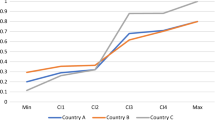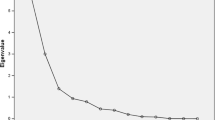Abstract
This paper analyzes some aggregation aspects of the procedure for constructing a composite index on a multidimensional socio-economic phenomenon such as development, the main focus being on the unbalance among individual dimensions. First a theoretical framework is set up for the unbalance adjustment of the index. Then an aggregation function is proposed that takes unbalance among development dimensions into account; a separate index is also introduced that measures the unbalance itself. Finally the dataset of the Index of African Governance for the year 2007 is used to test this method and compare it against the weighted arithmetic mean of variables with relation to the measured values of unbalance, yielding significantly different results for ratings and rankings, which in addition show negative correlations with the unbalance adjustment values. The changes ensuing from the adjustment are commented for some countries.









Similar content being viewed by others
References
Annoni, P., & Kozovska, K. (2010). EU regional competitiveness index (RCI) 2010. Technical report EUR 24346 EN, Scientific and Technical Research Series, European Commission Joint Research Centre, Institute for the Protection and Security of the Citizen, Luxembourg.
Baker, D., Bhaduri, A., & Ocampo, J. A. (2005). The development imperative: Toward a people-centered approach. In E. Hershberg & C. Thornton (Eds.). New York: Social Science Research Council.
Boozer, M., Ranis, G., Stewart, F., & Suri, T. (2003). Paths to success: The relationship between human development and economic growth. Technical Report 874, Discussion Papers, Economic Growth Center, Yale University, December.
Bourguignon, F. (2004). The poverty-growth-inequality triangle. Technical report 125, working papers, Indian Council For Research on International Economic Relations, New Delhi, March.
Broyer, S., & Savry, G. (2002). German leading indicators: Which one should be monitored?. CDC IXIS Capital Markets Flash, 38, 1–10.
Casadio Tarabusi, E., & Palazzi, P. (2004). An index for sustainable development. BNL Quarterly Review, 229, 185–206; Italian transl., Un indice per lo sviluppo sostenibile, Moneta e Credito 226, 123–149.
Chakravarty, S. R. (2003). A generalized human development index. Review of Development Economics, 7(1), 99–114.
Corsi, M., & Guarini, G. (2011). Measuring progress of Italian regions: A classical approach. Ekonomiaz, Basque Economic Journal, 78, 340–367.
De Muro, P., Mazziotta, M., & Pareto, A. (2008). Composite indices for multidimensional development and poverty: An application to MDG indicators. World Food Day Workshop, MDG1: Where do we stand with the implementation eight years after?
Dunn L. F., Ekici T. , Lavrakas P. J., & Stec J. A. (2004). An index to track credit card debt and predict consumption. OSU Economics Working Paper WP04-04.
Huggins, R., & Davies, W. (2006). European Competitiveness Index 2006–07, Pontypridd, Wales.
Munda, G., & Nardo, M. (2009). Non-compensatory/non-linear composite indicators for ranking countries: A defensible setting. Applied Economics, 41, 1513–1523. doi:10.1080/00036840601019364.
Organisation for Economic Co-operation and Development. (2008). Handbook on constructing composite indicators: Methodology and user guide.
Palazzi, P., & Lauri, A. (1998). The Human Development Index: Suggested corrections. BNL Quarterly Review, 205, 193–221.
Ranis, G. (2006). Human development and economic growth. The Elgar companion to development studies, 250–256.
Ranis, G., & Stewart, F. (1997). Growth and human development: Pakistan in comparative perspective. I. The Pakistan Development Review, 36(4), 333–352.
Ranis, G., & Stewart, F. (2000). Strategies for success in human development. Journal of Human Development, 1(1), 49–69.
Ranis, G., Stewart, F., & Ramirez, A. (2000). Economic growth and human development. World Development, 28(2), 197–219.
Rotberg, R. I., & Gisselquist, R. M. (2009). Strengthening African governance: Index of African Governance results and rankings. Cambridge: Harvard Kennedy School.
Saltelli, A. (2007). Composite indicators between analysis and advocacy. Social Indicators Research, 81, 65–77. doi:10.1007/s11205-006-0024-9.
Sen, A. (1999a). Development as freedom. Oxford: Oxford University Press.
Sen, A. (1999b). Assessing human development. Human Development Report 1999, p. 23. (Special contribution).
Soubbotina, T. P. (2004). Beyond economic growth: An introduction to sustainable development, 2nd ed.. Washington, D.C.: WBI Learning Resources Series, World Bank.
Soubbotina, T. P., & Sheram, K. A. (2000). Beyond economic growth: Meeting the challenges of global development. Washington, D.C.: WBI Learning Resources Series, World Bank.
Stiglitz, J. E., Sen, A., & Fitoussi, J.-P. (2009). Report by the commission on the measurement of economic performance and social progress.
Takayama, A. (1985). Mathematical economics, 2nd ed.. Cambridge: Cambridge University Press.
United Nations. (2010). The Millennium Development Goals Report 2010, New York.
United Nations Development Programme. (1991). Human development report 1991, New York.
United Nations Development Programme. (2009). Human development report 2009, New York.
Zelenyuk, V. (2006). Aggregation of Malmquist productivity indexes. European Journal of Operational Research, 174(2), 1076–1086. doi:10.1016/j.ejor.2005.02.061.
Acknowledgments
The authors wish to thank Marcella Corsi, Marco Marini and Paolo Palazzi for their useful comments. Research partially supported by the Ateneo della Scienza e della Tecnologia 2007 project Sviluppo economico e sviluppo civile secondo l'approccio di Paolo Sylos Labini, coordinated by Marcella Corsi.
Author information
Authors and Affiliations
Corresponding author
Additional information
This is a revised version of "An aggregation method for composite indicators with unbalance adjustment, with an application to the Index of African Governance”.
Rights and permissions
About this article
Cite this article
Casadio Tarabusi, E., Guarini, G. An Unbalance Adjustment Method for Development Indicators. Soc Indic Res 112, 19–45 (2013). https://doi.org/10.1007/s11205-012-0070-4
Accepted:
Published:
Issue Date:
DOI: https://doi.org/10.1007/s11205-012-0070-4
Keywords
- Development
- Rating
- Composite indicator
- Aggregation method
- Across-variables unbalance
- Across-variables compensability
- Index of African Governance




